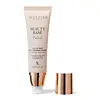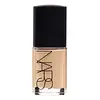Sculpted by Aimee Beauty Base Protect SPF50 All-In-One Moisturising Primer Versus NARS Cosmetics Sheer Glow Foundation
What's inside
What's inside
 Key Ingredients
Key Ingredients

 Benefits
Benefits

 Concerns
Concerns

 Ingredients Side-by-side
Ingredients Side-by-side

Water
Skin ConditioningButyloctyl Salicylate
Skin ConditioningGlycereth-26
HumectantEthylhexyl Salicylate
UV AbsorberGlycerin
HumectantCI 77891
Cosmetic ColorantDibutyl Adipate
EmollientCoco-Caprylate/Caprate
EmollientPentaerythrityl Tetraisostearate
EmollientBis-Ethylhexyloxyphenol Methoxyphenyl Triazine
Skin ConditioningMica
Cosmetic ColorantGlyceryl Stearate
EmollientPEG-100 Stearate
1,2-Hexanediol
Skin ConditioningMethyl Methacrylate Crosspolymer
Cetyl Alcohol
EmollientAcrylates Copolymer
Caprylyl Methicone
Skin ConditioningCeteareth-20
CleansingOleth-10
EmulsifyingTrideceth-9
EmulsifyingStearic Acid
CleansingAluminum Hydroxide
EmollientPolysorbate 80
EmulsifyingHydroxyacetophenone
AntioxidantPhenoxyethanol
PreservativePolyglyceryl-3 Distearate
EmulsifyingAmmonium Acryloyldimethyltaurate/Vp Copolymer
Parfum
MaskingSodium Polyacrylate
AbsorbentPalmitic Acid
EmollientCI 77492
Cosmetic ColorantBetaine
HumectantAllantoin
Skin ConditioningTrehalose
HumectantPanthenol
Skin ConditioningHydroxyethylcellulose
Emulsion StabilisingTriethoxycaprylylsilane
Ethylhexylglycerin
Skin ConditioningSodium Hyaluronate
HumectantCaprylyl Glycol
EmollientTocopherol
AntioxidantGlyceryl Stearate Citrate
EmollientSodium Phytate
Arginine
MaskingCI 77491
Cosmetic ColorantPotassium Cetyl Phosphate
EmulsifyingPolyacrylate Crosspolymer-6
Emulsion StabilisingMyristic Acid
CleansingSilica
AbrasiveT-Butyl Alcohol
PerfumingButylene Glycol
HumectantPolyglyceryl-10 Laurate
Skin ConditioningAcetyl Hexapeptide-8
HumectantCopper Tripeptide-1
Skin ConditioningTripeptide-1
Skin ConditioningPalmitoyl Pentapeptide-4
Skin ConditioningHexapeptide-9
Skin ConditioningWater, Butyloctyl Salicylate, Glycereth-26, Ethylhexyl Salicylate, Glycerin, CI 77891, Dibutyl Adipate, Coco-Caprylate/Caprate, Pentaerythrityl Tetraisostearate, Bis-Ethylhexyloxyphenol Methoxyphenyl Triazine, Mica, Glyceryl Stearate, PEG-100 Stearate, 1,2-Hexanediol, Methyl Methacrylate Crosspolymer, Cetyl Alcohol, Acrylates Copolymer, Caprylyl Methicone, Ceteareth-20, Oleth-10, Trideceth-9, Stearic Acid, Aluminum Hydroxide, Polysorbate 80, Hydroxyacetophenone, Phenoxyethanol, Polyglyceryl-3 Distearate, Ammonium Acryloyldimethyltaurate/Vp Copolymer, Parfum, Sodium Polyacrylate, Palmitic Acid, CI 77492, Betaine, Allantoin, Trehalose, Panthenol, Hydroxyethylcellulose, Triethoxycaprylylsilane, Ethylhexylglycerin, Sodium Hyaluronate, Caprylyl Glycol, Tocopherol, Glyceryl Stearate Citrate, Sodium Phytate, Arginine, CI 77491, Potassium Cetyl Phosphate, Polyacrylate Crosspolymer-6, Myristic Acid, Silica, T-Butyl Alcohol, Butylene Glycol, Polyglyceryl-10 Laurate, Acetyl Hexapeptide-8, Copper Tripeptide-1, Tripeptide-1, Palmitoyl Pentapeptide-4, Hexapeptide-9
Water
Skin ConditioningDimethicone
EmollientTriethylhexanoin
MaskingButylene Glycol
HumectantGlycerin
HumectantIsostearic Acid
CleansingPolymethylsilsesquioxane
PEG-10 Dimethicone
Skin ConditioningDisteardimonium Hectorite
StabilisingDimethicone/Vinyl Dimethicone Crosspolymer
Skin ConditioningBis-Butyldimethicone Polyglyceryl-3
CleansingSodium Glutamate
MaskingSorbitan Sesquiisostearate
EmulsifyingPaeonia Albiflora Root Extract
Skin ConditioningCurcuma Longa Root Extract
MaskingPolysilicone-2
Aluminum Hydroxide
EmollientTocopherol
Antioxidant1-Methylhydantoin-2-Imide
Skin ConditioningAscorbyl Glucoside
AntioxidantGlucosyl Hesperidin
HumectantPhenoxyethanol
PreservativeSodium Dehydroacetate
PreservativeBenzoic Acid
MaskingIron Oxides
CI 77891
Cosmetic ColorantWater, Dimethicone, Triethylhexanoin, Butylene Glycol, Glycerin, Isostearic Acid, Polymethylsilsesquioxane, PEG-10 Dimethicone, Disteardimonium Hectorite, Dimethicone/Vinyl Dimethicone Crosspolymer, Bis-Butyldimethicone Polyglyceryl-3, Sodium Glutamate, Sorbitan Sesquiisostearate, Paeonia Albiflora Root Extract, Curcuma Longa Root Extract, Polysilicone-2, Aluminum Hydroxide, Tocopherol, 1-Methylhydantoin-2-Imide, Ascorbyl Glucoside, Glucosyl Hesperidin, Phenoxyethanol, Sodium Dehydroacetate, Benzoic Acid, Iron Oxides, CI 77891
 Reviews
Reviews

Ingredients Explained
These ingredients are found in both products.
Ingredients higher up in an ingredient list are typically present in a larger amount.
Aluminum Hydroxide is a form of aluminum. It can be naturally found in nature as the mineral gibbsite. In cosmetics, Aluminum Hydroxide is used as a colorant, pH adjuster, and absorbent.
As a colorant, Aluminum Hydroxide may add opacity, or reduce the transparency. Aluminum hydroxide is contains both basic and acidic properties.
According to manufacturers, this ingredient is an emollient and humectant. This means it helps hydrate the skin.
In medicine, this ingredient is used to help relieve heartburn and help heal ulcers.
There is currently no credible scientific evidence linking aluminum hydroxide in cosmetics to increased cancer risk.
Major health organizations allow the use of aluminum hydroxide in personal care products and have not flagged it as a carcinogenic risk at typical usage levels.
Learn more about Aluminum HydroxideButylene Glycol (or BG) is used within cosmetic products for a few different reasons:
Overall, Butylene Glycol is a safe and well-rounded ingredient that works well with other ingredients.
Though this ingredient works well with most skin types, some people with sensitive skin may experience a reaction such as allergic rashes, closed comedones, or itchiness.
Learn more about Butylene GlycolCi 77891 is a white pigment from Titanium dioxide. It is naturally found in minerals such as rutile and ilmenite.
It's main function is to add a white color to cosmetics. It can also be mixed with other colors to create different shades.
Ci 77891 is commonly found in sunscreens due to its ability to block UV rays.
Learn more about CI 77891Glycerin is already naturally found in your skin. It helps moisturize and protect your skin.
A study from 2016 found glycerin to be more effective as a humectant than AHAs and hyaluronic acid.
As a humectant, it helps the skin stay hydrated by pulling moisture to your skin. The low molecular weight of glycerin allows it to pull moisture into the deeper layers of your skin.
Hydrated skin improves your skin barrier; Your skin barrier helps protect against irritants and bacteria.
Glycerin has also been found to have antimicrobial and antiviral properties. Due to these properties, glycerin is often used in wound and burn treatments.
In cosmetics, glycerin is usually derived from plants such as soybean or palm. However, it can also be sourced from animals, such as tallow or animal fat.
This ingredient is organic, colorless, odorless, and non-toxic.
Glycerin is the name for this ingredient in American English. British English uses Glycerol/Glycerine.
Learn more about GlycerinPhenoxyethanol is a preservative that has germicide, antimicrobial, and aromatic properties. Studies show that phenoxyethanol can prevent microbial growth. By itself, it has a scent that is similar to that of a rose.
It's often used in formulations along with Caprylyl Glycol to preserve the shelf life of products.
Tocopherol (also known as Vitamin E) is a common antioxidant used to help protect the skin from free-radicals and strengthen the skin barrier. It's also fat soluble - this means our skin is great at absorbing it.
Vitamin E also helps keep your natural skin lipids healthy. Your lipid skin barrier naturally consists of lipids, ceramides, and fatty acids. Vitamin E offers extra protection for your skin’s lipid barrier, keeping your skin healthy and nourished.
Another benefit is a bit of UV protection. Vitamin E helps reduce the damage caused by UVB rays. (It should not replace your sunscreen). Combining it with Vitamin C can decrease sunburned cells and hyperpigmentation after UV exposure.
You might have noticed Vitamin E + C often paired together. This is because it is great at stabilizing Vitamin C. Using the two together helps increase the effectiveness of both ingredients.
There are often claims that Vitamin E can reduce/prevent scarring, but these claims haven't been confirmed by scientific research.
Learn more about TocopherolWater. It's the most common cosmetic ingredient of all. You'll usually see it at the top of ingredient lists, meaning that it makes up the largest part of the product.
So why is it so popular? Water most often acts as a solvent - this means that it helps dissolve other ingredients into the formulation.
You'll also recognize water as that liquid we all need to stay alive. If you see this, drink a glass of water. Stay hydrated!
Learn more about Water